Do Work Imac Background Flowers Background Simple

The Background Eraser Tool In Photoshop
In this tutorial, we'll acquire all most the Background Eraser Tool in Photoshop and how to apply it to easily remove background areas of an image.
The Background Eraser Tool is especially useful with photos that contain lots of fine detail along the edges between your subject and its background, like, for case, if you lot want to erase the sky in an image without erasing the trees below it.
Only don't allow the proper name fool you. The Groundwork Eraser really has nothing to practise with erasing backgrounds, since Photoshop has no way of knowing what's considered the background in a photograph and what isn't. It can just every bit hands exist used to erase whatever role of an image, and that'due south because the Background Eraser is really a color eraser. Information technology samples colors equally you elevate the tool over them and erases simply those colors, leaving all other colors untouched. So if your heaven is blue and your trees are green, the Background Eraser can easily erase the blue heaven while leaving the green trees alone, at least until someone comes along and cuts them down, which gives us all the more than reason to protect them in the epitome.
This version of our Background Eraser tutorial has been updated for Photoshop CS6 and is also fully uniform with Photoshop CC (Creative Cloud). If y'all're using Photoshop CS5 or earlier, you can still follow along here, or you can cheque out the original Background Eraser tutorial.
The Background Eraser is, without a dubiousness, one of the all-time tools in Photoshop for removing unwanted areas of a photograph, merely it's not perfect and it does have 1 serious drawback. Every bit an eraser tool, it physically deletes pixels from the image, which means that once they're gone, they're gone for skilful. To avoid dissentious your original image, it's a good idea to indistinguishable your Background layer first before erasing whatsoever pixels, or work on a separate copy of your image.
How To Remove Backgrounds With Photoshop
Selecting The Groundwork Eraser Tool
Past default, the Background Eraser is hiding behind Photoshop's regular Eraser Tool in the Tools panel. To select it, correct-click (Win) / Control-click (Mac) on the Eraser Tool, and so cull the Background Eraser Tool from the wing-out menu that appears:
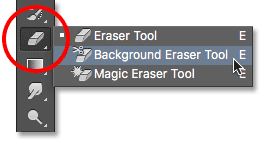
The Background Eraser Tool is found nested under the regular Eraser Tool in the Tools console.
With the Background Eraser selected, your mouse cursor volition change into a circle with a small crosshair in the centre of it:
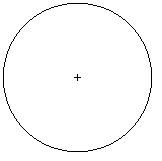
The Background Eraser's cursor is made up of a simple circle with a crosshair in the heart.
Adjusting The Size Of The Brush
The Groundwork Eraser Tool is really a brush, and just like Photoshop's other Brush tools, you can arrange its size directly from your keyboard. Printing the left bracket key ( [ ) repeatedly to get in smaller or the right bracket key ( ] ) to arrive larger. You can also adjust the hardness of the edges by adding the Shift fundamental. Press Shift+left subclass ( [ ) repeatedly to make the edges softer or Shift+right subclass ( ] ) to make them harder. In general, you lot'll want to use hard edges with the Groundwork Eraser since soft edges can go out many background artifacts behind.
How The Background Eraser Works
Before we expect at a real-earth case of Photoshop'due south Groundwork Eraser Tool in activeness, let's larn the basics of how it works. Hither'south a elementary paradigm made up of zilch more than a few blue and green vertical columns:
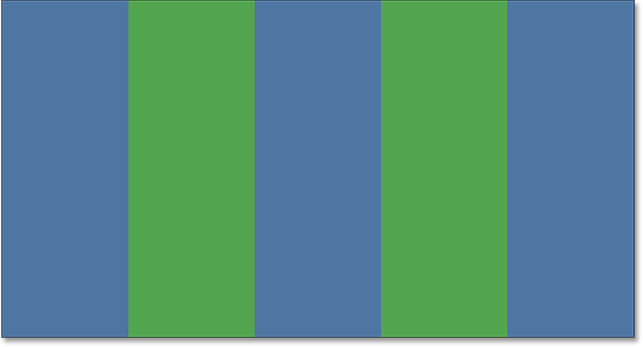
Another masterpiece created in Photoshop.
If we look in my Layers console, we see that the image is sitting on the Groundwork layer:
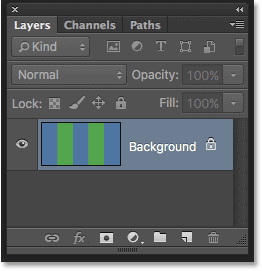
The Layers console.
Let'south say I want to erase the blue column in the middle without erasing the greenish columns on either side of information technology. The way the Groundwork Eraser works (by default, anyway) is that Photoshop samples the color that'southward direct underneath the crosshair in the eye of the circle. The larger circle surrounding the crosshair represents the expanse where Photoshop will erase pixels. Whatsoever pixels inside the circle that match the color of the pixel straight nether the crosshair will be erased.
To erase the blueish center column, I'll move the cursor into the blue area, making sure that the crosshair in the centre is straight over the blue color I want to erase:
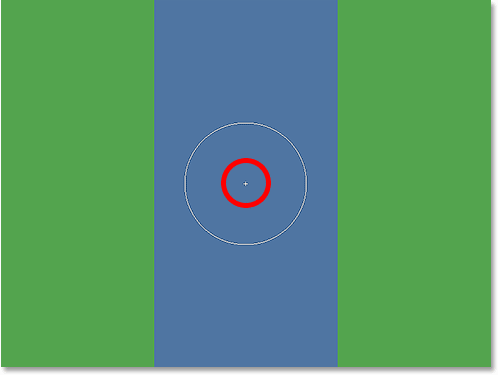
Positioning the crosshair over an area of blue.
When I click my mouse button, Photoshop samples the blue color under the crosshair and erases all of the matching blue pixels that fall within the larger circle:
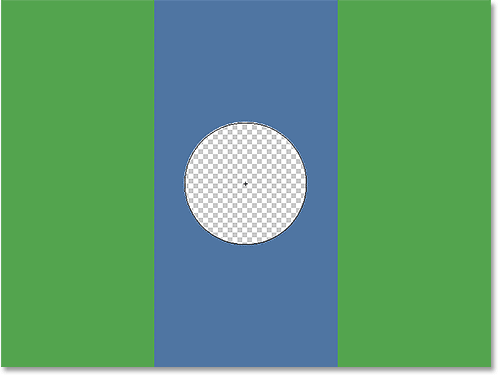
Only the pixels inside the circle are deleted.
To erase more of the blueish column, I simply need to proceed holding my mouse button down every bit I drag the Background Eraser over more than of the area. Notice that even though the circle sometimes extends into one of the green columns, they remain untouched, and that'south because those pixels are not the same colour as the colour that Photoshop sampled. This makes it easy to get right upwardly along the edges of the area I want to erase. As long as I keep the crosshair inside the blueish expanse, Photoshop will only erase blue pixels:
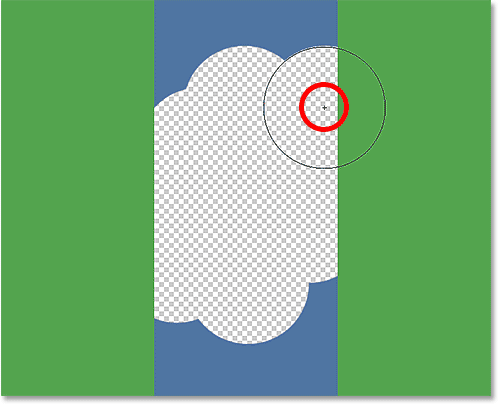
You tin move the cursor into other colors in the image without erasing them as long every bit you keep the crosshair away from them.
Withal, if I accidentally motion the crosshair over an area of green, Photoshop samples the green colour and starts erasing green pixels:
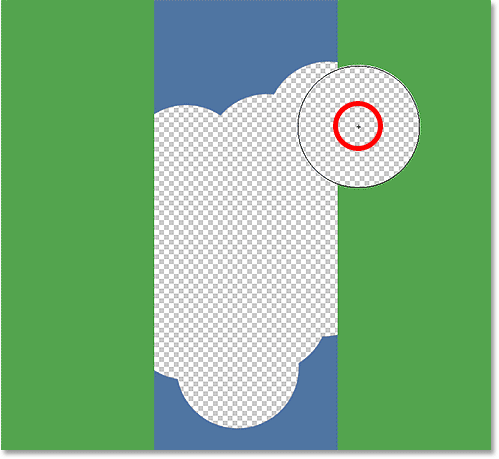
Moving the crosshair over a new color causes Photoshop to change the color information technology'south erasing.
If you brand a mistake similar this, just printing Ctrl+Z (Win) / Command+Z (Mac) on your keyboard to undo it. If you demand to undo multiple steps, press Ctrl+Alt+Z (Win) / Command+Option+Z (Mac) repeatedly.
A Quick Note About The Background Layer
Notice the checkerboard blueprint that appears in place of the areas I've erased. That'due south Photoshop'southward way of representing transparency on a layer, which, if you're familiar with Photoshop, may accept you wondering what'south going on here. A moment ago, we saw that my image was sitting on the Groundwork layer. Photoshop treats Groundwork layers differently from normal layers, with different rules for what we can and can't practise with them.
One of the things we tin can't do is erase pixels on them, since transparency is not allowed on a Background layer (after all, information technology's the background, and not being able to run into through it is part of what makes it a groundwork). How, and so, did I manage to erase the pixels? Is at that place some sort of "Extra Force" setting for the Background Eraser that we oasis't looked at notwithstanding?
Nope. What happened is that Photoshop assumed I knew what I doing (non always the best supposition to make) and, rather than tossing up an mistake message complaining that I can't delete pixels on a Background layer, it automatically converted the Background layer into a regular layer, which information technology named "Layer 0". This isn't annihilation terribly important, or even remotely interesting, but it's still good to know what'due south going on:
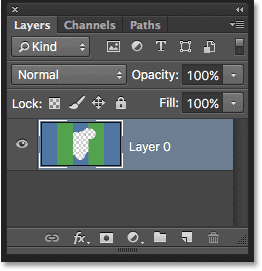
When using the Background Eraser on the Groundwork layer, Photoshop converts it to a normal layer for usa.
Let'southward take what we've learned so far and wait at a real-world example of the Groundwork Eraser Tool in activity. As I brand my way effectually the tree in this photo, the Background Eraser has lilliputian trouble erasing the blue heaven while leaving the tree itself untouched, as long as I keep the crosshair over the sky and away from the tree:
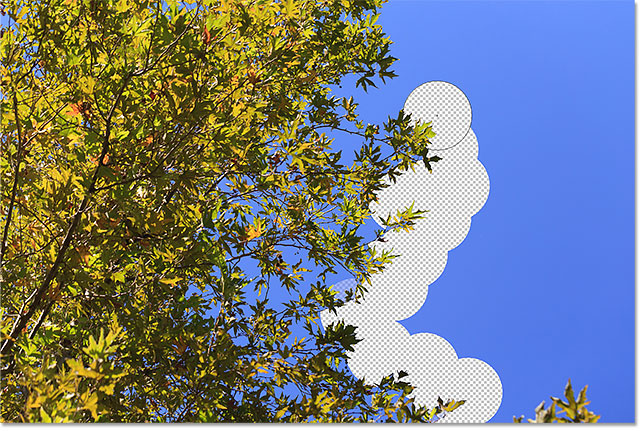
Even though the Groundwork Eraser's cursor extends into the tree, just the blue sky is erased.
Withal, if I sideslip and move the crosshair over one of the leaves, then Photoshop samples the new color and starts erasing the tree, in which case I'd need to printing Ctrl+Z (Win) / Command+Z (Mac) on my keyboard to disengage the last footstep and try again:
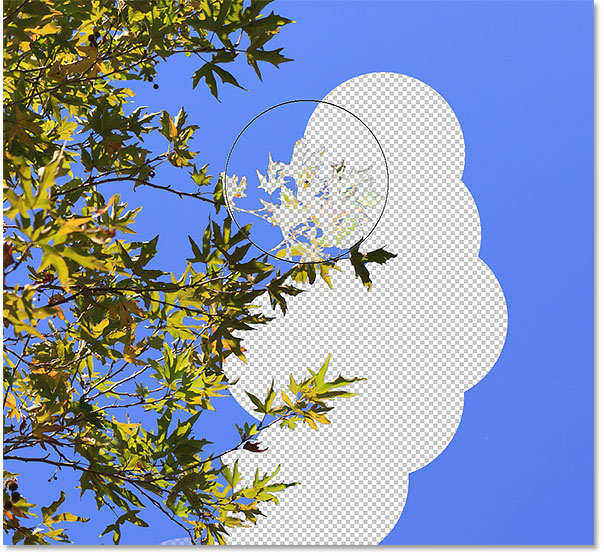
Photoshop has no thought what the heaven or a tree is. It cares only about the color nether the crosshair.
So far, we know that Photoshop samples the color directly under the crosshair in the eye of the Groundwork Eraser's cursor, and that it erases any pixels of the same color that fall within the larger circle. We also know that if we movement the crosshair over a dissimilar color as nosotros're dragging the Background Eraser effectually, Photoshop volition sample the new colour and use it as the color information technology should exist erasing.
What we've simply described hither is the default behavior of the Groundwork Eraser Tool, just it'southward non the only fashion the tool can behave. So how practice we change things? Nosotros practice that using the settings institute in the Options Bar. Let's check them out.
Sampling Options
Whenever we accept the Background Eraser Tool selected, the Options Bar forth the peak of the screen displays various options for decision-making how the tool behaves. 1 of the most of import behaviors we can change is how Photoshop samples colors under the crosshair, or if it samples them at all.
Over on the left of the Options Bar, you'll discover a set of three icons. These are the Sampling Options, and each icon selects a dissimilar behavior. From left to right, we have Continuous, Once and Background Swatch:

The sampling options: Continuous (left), Once (middle) and Background Swatch (right).
Of the three, the ii you'll switch between the nigh are Continuous (the icon on the left) and In one case (the middle icon). Continuous is selected by default, and it ways that every bit we movement the Background Eraser around, Photoshop continuously samples the color nether the crosshair. That'southward why, when I accidentally moved the crosshair over the green column or the green tree, Photoshop started erasing green pixels even though I was initially erasing blue pixels.
The Continuous sampling choice works great when the background you're trying to erase contains multiple colors. But if the color of your background doesn't change much, the Once pick usually works better. I'll select it past clicking on the middle icon:

Selecting the In one case sampling choice in the Options Bar.
As you may take guessed from its proper noun, In one case tells Photoshop to sample the colour nether the crosshair one time and that'southward it. Whichever color is nether the crosshair the moment you click your mouse button is the color that Photoshop will erase no matter how many other colors yous drag the crosshair over (as long as you go on your mouse push button held downward). Watch what happens now when I "accidentally" motility the crosshair over the green column. The Background Eraser has no issue on it this time because the crosshair was over the blue column when I clicked and held down my mouse button:
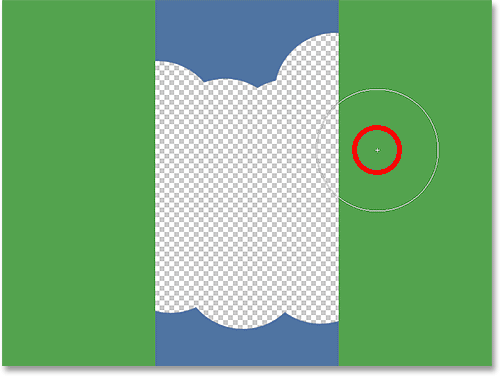
Photoshop no longer erases the green column fifty-fifty though the crosshair has moved over the light-green color.
We see the same thing happening in our photograph. With Once selected as the sampling option, Photoshop is able to ignore the leaves this time even though I've moved the crosshair over them, and that'due south because I initially clicked on the blue sky:
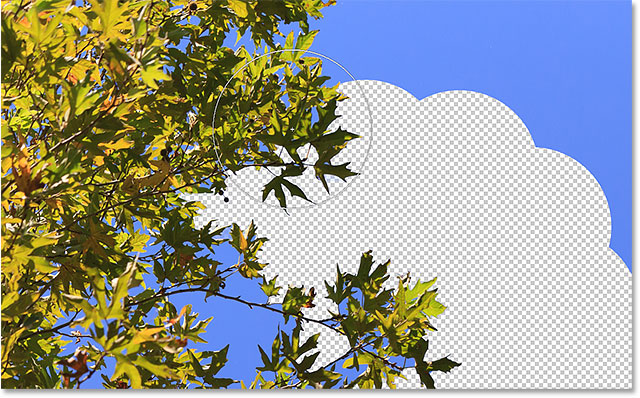
With Once selected, the only color Photoshop volition erase is the one that was sampled initially.
If you're having trouble positioning the crosshair over the color y'all desire to erase, try the Background Swatch sampling choice (the icon on the right):

Selecting the Background Swatch sampling option.
With Background Swatch selected, click on the Groundwork color swatch in the Tools panel and choose a color from the Color Picker that matches (as close every bit possible, anyway) the color in your image that you want to erase. If the colour y'all've selected isn't quite correct, adapt the Tolerance value in the Options Bar (which we'll expect at in a moment) until you're able to erase the pixels:

With the Groundwork Swatch sampling option selected, choose a Groundwork color similar to the color you need to erase.
Limits
Another important selection for the Background Eraser is Limits. Once Photoshop knows which color yous want to erase, Limits tells it where information technology can look for pixels that match that color so it can erase them. The three options for Limits are Contiguous, Discontiguous and Find Edges:

The Limits choice.
Contiguous, the default setting, means that Photoshop can just erase pixels in areas that are physically touching the pixel under the crosshair. In other words, it can't jump across tree branches, debate posts, or anything else in the photo that separates one expanse of pixels from another. Here nosotros see that while the Background Eraser has no trouble erasing the heaven around the outside of the tree, the Contiguous option is preventing it from deleting the isolated blue areas between the leaves and branches. Nosotros'll run across how to get around this trouble in a moment:
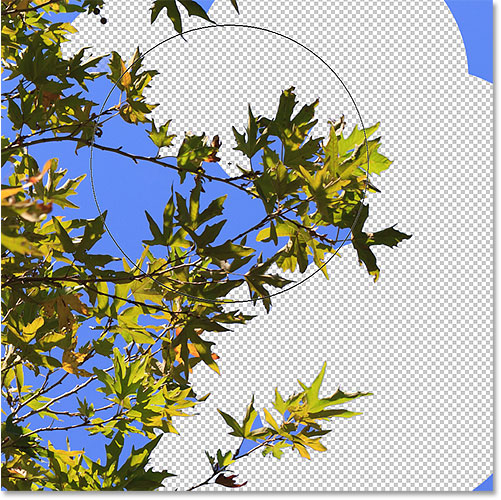
The branches on the tree act equally road blocks for the Background Eraser as information technology tries to delete the bluish sky pixels.
If you notice that Photoshop is having trouble maintaining the sharpness of the edges effectually the subject you lot're trying to keep (in other words, some of the border is fading away), attempt undoing your steps then switching the Limits choice to Notice Edges:

Changing the Limits option to Find Edges.
Find Edges is similar to Contiguous in that it tin can only delete pixels that are physically touching the pixel under the crosshair, and then it won't assist me access those areas of blue sky that are trapped between the leaves and branches. Still, Find Edges is more precise than Face-to-face and improve at maintaining abrupt edge detail. Again, I don't actually demand to utilize it here with these leaves, but if I was deleting the sky along the edge of a building, for case, where maintaining the precipitous edges of the building would be important, then Detect Edges would be a great choice:
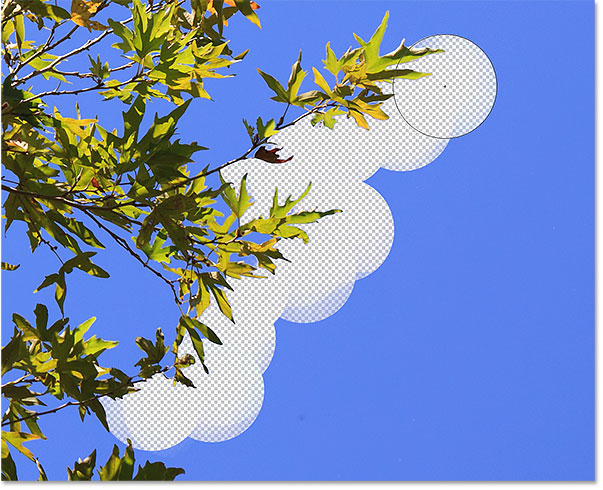
Find Edges is more precise, but tin can also be a bit slower to piece of work with than Contiguous.
And then, what about those isolated areas of blue sky in my image that I can't become to with either Face-to-face or Discover Edges? That'south what the third Limits selection, Discontiguous, is for:

Selecting Discontiguous for the Limits choice in the Options Bar.
Discontiguous means that Photoshop is free to erase any pixels anywhere in the prototype that lucifer our sampled color, whether they're touching the crosshair or not. As long as the pixels fall inside the larger circle surrounding the crosshair, they're fair game. In my example, it ways that once I've clicked the crosshair on an area of bluish sky, I tin simply elevate the Groundwork Eraser around inside the tree to easily erase any areas of sky showing through it. I as well have my sampling option set to One time so Photoshop doesn't change the color being erased equally I move over the tree:
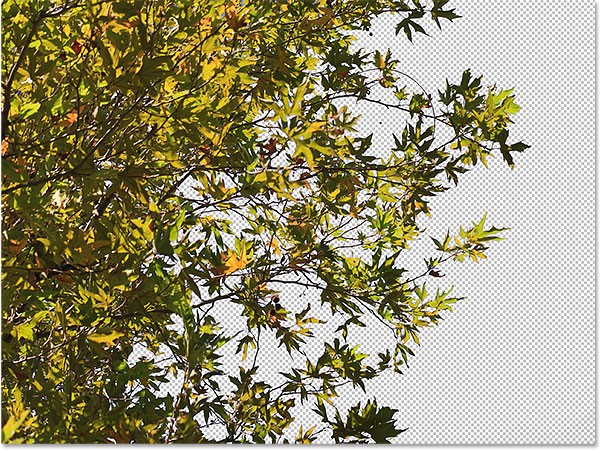
With Limits set to Discontiguous, erasing the blueish sky through the tree is as easy every bit dragging the Background Eraser around.
Unfortunately, if nosotros look closely, we tin see some darker blue areas of the sky remaining around the leaves and branches. I've added a black groundwork behind the prototype to get in easier to encounter. Even with the Limits option set to Discontiguous, the Background Eraser still needs a little more than assist with this image. This brings us to the tertiary important option for the Background Eraser, and one that can make all the difference when information technology comes to using the tool successfully - Tolerance. We'll await at it next:
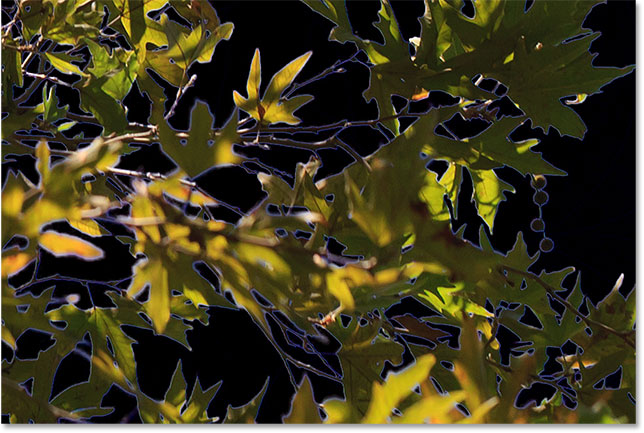
Some bluish fringing still remains.
Tolerance
The third of the three major options for the Background Eraser is Tolerance, which determines how different a pixel's color can be from the sampled color for Photoshop to erase it. You'll find the Tolerance option straight to the right of the Limits option in the Options Bar:

Use Tolerance to control how similar a pixel color needs to be to the sampled colour for information technology to be erased.
The default Tolerance value is 50% and that's commonly a good identify to start. Only if the color of your background is too similar to your field of study, causing function of your subject to be erased, effort a lower Tolerance setting. If, on the other hand, yous notice background color fringing around the edges, as I practise hither, attempt a college Tolerance value.
I'm going to undo my previous steps with the Background Eraser then I can attempt again, and since my heaven is quite a scrap different in color from the tree, I'll increment my Tolerance value to seventy%. I'll click to sample an area of blue sky with the crosshair, and this time, with the college Tolerance setting, the Background Eraser is able to do a much better job with cleaner results:
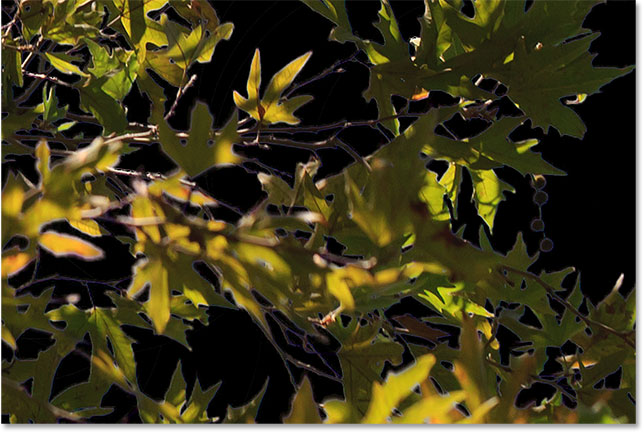
With a college Tolerance setting, the Background Eraser was able to avert the blue fringing forth the edges.
Protect Foreground Color
Finally, if you notice that no matter what Tolerance setting you try, you lot just can't seem to get the Background Eraser to erase the groundwork in your image without taking office of your subject along with it, try the Protect Foreground Color option. By default, it's turned off:

The Protect Foreground Colour option in the Options Bar, currently deselected.
Protect Foreground Colour allows us to sample a color from the image to prepare every bit our new Foreground color. Photoshop will then protect this color, preventing it from being erased (hence the name "Protect Foreground Color"). In this photo, the flowers are too similar to the background, causing the Background Eraser to erase office of the flowers forth with the heaven:
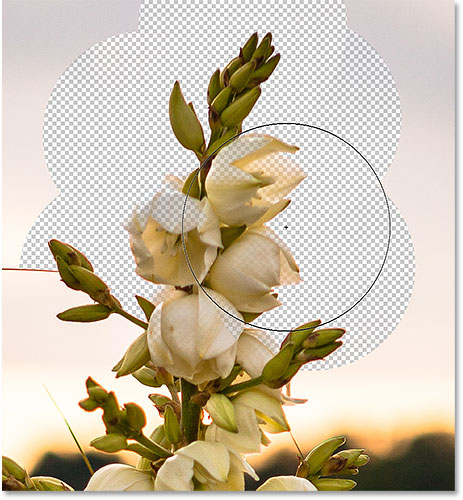
Photoshop has a tough fourth dimension finding the edges when the discipline and groundwork are also similar.
To overcome this problem, I'll first undo my last step by pressing Ctrl+Z (Win) / Control+Z (Mac). Then, I'll select the Protect Foreground Color pick by clicking inside its checkbox:

Turning Protect Foreground Color on.
To sample a colour from the image, I'll press and hold the Alt (Win) / Choice (Mac) key on my keyboard, which temporarily switches me to the Eyedropper Tool, then I'll click on i of the flowers to sample that color. This will become the color that Photoshop protects:
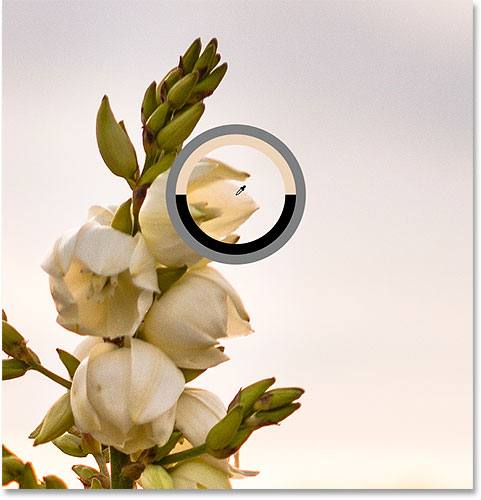
Hold down Alt (Win) / Pick (Mac) and click on a color to protect.
If y'all wait at your Foreground color swatch well-nigh the bottom of the Tools panel, you'll meet that the color you sampled has become your new Foreground color:

The sampled colour appears in the Foreground colour swatch.
With that color at present protected, I'll once again drag around the flowers with the Groundwork Eraser to remove the sky, and this time, things piece of work out much meliorate. Photoshop is able to erase the sky and leave the flowers intact. Just call up to deselect the Protect Foreground Color pick when you're washed, otherwise the side by side time you go to use the Background Eraser, you could get unexpected results:

The groundwork goes, the flowers get to stay.
Photoshop Background Eraser Tool - Quick Summary
We covered a lot in this tutorial. Here's a summary of what nosotros've learned:
- Photoshop'south Background Eraser Tool can exist used to easily remove unwanted areas of an image.
- To select the Background Eraser Tool, right-click (Win) / Control-click (Mac) on the standard Eraser Tool in the Tools console, and then select the Groundwork Eraser Tool from the carte.
- To erase part of the paradigm, position the crosshair in the heart of the castor cursor over the color you want to erase, and then click to sample the color. Continue your mouse button held down and drag the cursor over the image. Whatever pixels the cursor passes over that friction match the sampled color volition exist erased.
- Pixels that do not match the sampled colour will be ignored.
- The Sampling Options in the Options Bar control the beliefs of the Background Eraser Tool.
- Continuous (default) tells Photoshop to continuously sample the color under the crosshair as yous drag the cursor.
- Once samples only the initial color y'all click on. No other colors will be sampled while your mouse button is held down, even if y'all pass the crosshair over unlike colors.
- Background swatch will erase pixels that match your current Background color.
- The Limits option in the Options Bar determines where Photoshop can look for pixels to erase.
- Face-to-face (default) means that Photoshop can only erase pixels in areas that are physically touching the pixel under the crosshair. It volition ignore pixels that match the sampled colour but are separated by an area of a different color.
- Discontiguous will erase any pixels that match the sampled color that the crosshair passes over, fifty-fifty if they are separated by an area of a unlike color.
- Find Edges is similar to Contiguous but more precise and better at maintaining sharp edge detail.
- Tolerance determines how different a pixel's color can be from the sampled color for Photoshop to erase information technology. Use a lower Tolerance value when your subject and background colors are more similar. Higher Tolerance values can help remove edge fringing when your subject field and background colors are more unlike.
- Protect Foreground Color prevents your current Foreground colour from existence erased. Press and concur Alt (Win) / Option (Mac) and click on your discipline to sample a color and set it as your new Foreground color.
- If you make a mistake with the Background Eraser Tool, press Ctrl+Z (Win) / Command+Z (Mac) to undo your last brush stroke, and then try again.
And there we accept information technology! That'south how to easily erase background areas of an image using the Background Eraser Tool in Photoshop! Check out our Photo Retouching department for more image editing tutorials!
Other Stuff
© 2022 Photoshop Essentials.com.
For inspiration, non duplication.
Site design by Steve Patterson.
Photoshop is a trademark of Adobe Systems Inc.
Do Work Imac Background Flowers Background Simple,
Source: https://www.photoshopessentials.com/photo-editing/background-eraser/
Posted by: daviskniout.blogspot.com


0 Response to "Do Work Imac Background Flowers Background Simple"
Post a Comment